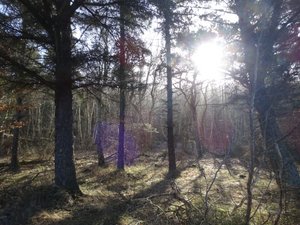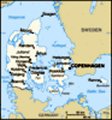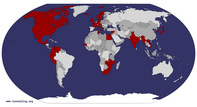Advertisement
Published: March 9th 2019

 Forest
Forest
Tisvilde HegnDear All
Hello again, for my third and final update on my lovely little winter trip to Denmark. I had enjoyed two full days of sightseeing until this point, around Copenhagen first, and then two royal castles situated in Hillerød and Helsingør in northern Zealand. For my final full day, I wanted to explore more of the natural beauty of this part of the world, and planned a visit which would take in both coast and forest, and after ending up with some additional time towards the end of the day, I also managed to fit in a lake. Whilst so far I had visited some quite famous tourist sights of Denmark, this final day enabled me to really get off-the-beaten track, and just explore what was around me in the natural north of Zealand. It was a very enjoyable, and peaceful, day indeed.
Neither the Lonely Planet nor the Rough Guide books, which I’d borrowed from my local library, had any information for this part of the world for me, so I planned my day using the amazing Maps.Me app. Similar to Google Maps, except far more accurate in its mapping to my mind, and much easier to

 Coast
Coast
Tisvilde Hegndownload whilst on WiFi and use when off-grid, it really turned out to be quite a boon in locating the trickier paths to find during my journey, and its GPS navigation pointer is just so accurate. I would highly recommend Maps.Me to anyone considering using GPS navigation whilst travelling.
I began my day, after breakfast, by taking a train northwards to the small, out-of-season summer coastal resort of Tisvildeleje. Apparently, Danish sun-seekers flock to this stretch of the north Zealand coastline in their throngs during the summer months, between Tisvildeleje and Gilleleje to the east. During my visit, most tourist-related establishments were closed, the sun was shining, although it was darned cold and windy, and I had most of the beach to myself. I walked a short distance from the train station to the beach, and was greeted by stunning coastal vistas to both west and east. It was lovely just sitting there for a while, hearing the waves roll in and out, and breathing in the fresh sea air.
A short walk westwards brought me to the entrance to what has been referred to as one of Denmark’s most beautiful forests, the Tisvilde Hegn. I had planned

 Lake
Lake
Arresø Laketo spend most of my day exploring these woods, and visiting various points of interest scattered throughout as shown in the map I had downloaded from the forest’s webpage. The forest as it is today is interestingly only three centuries old, the planting of it initiated in 1724 by a “tough gentleman” from Germany called John Ulrich Røhl. Around the 16
th century, so much deforestation in the area had led to what is referred to as a “sand escape” or “sand flight”, whereby the nutrient-poor soil was blown away by the wind, and huge sand dunes began to build up in the area, up to 30 metres high. The dunes buried the villages and farmland, and turned the area into a sand dune desert. Røhl had been called upon to return the area back to its original forest cover, and began to dig ditches and replant trees throughout the area. Amazingly, the entire region was converted back into forest land again by 1900. What an incredible feat of ecological engineering! My walk through the forest was just lovely, and there were practically no signs that a mere couple of centuries ago the area was covered in sand dunes.
I

 Entrance
Entrance
Christianiabegan by heading west along the coastal Strandvejen pathway, guided by both my amazing app and the numerous boulders in the area showing directions to various places. My first destination aimed for was the Troldeskoven, referred to in English as the Troll Forest or the Magic Forest. Upon arrival, I walked among some amazingly crooked and distorted trees, supposedly shaped that way by the wind and an attack of some tree larvae. Making my way up, under and over these spooky tree shapes, I ended up back at the coastline in a remarkable dune area, with not a soul in sight for miles around. Perfect for some quiet contemplation.
After a while I headed back inland again, through the Troll Forest once more, and uphill past a large, electric-fenced enclosure, wondering what it was that was kept in there, and on to a great viewpoint called Harehøje. The viewpoint is actually situated on top of one of 59 Bronze Age burial mounds in the area, and afforded great views back down to the coast and the sea beyond, as well as into the forest behind. I then headed from here through the Juniper Valley, and past a really sad
and melancholic area of land which had been felled by loggers. I am sure that the area is responsibly and sustainably managed and logged, but for the first time in seeing such a place, I really felt a sense of loss for the trees… Perhaps I’m just getting too sentimental in my old age…
After passing through the valley, I passed by a stone monument to a gentleman called Fr. Bang. I’m not really sure who he was, whether he was a Father or priest or something, but I did learn that he was responsible for planting 450 acres of the forest between 1885 and 1896, and is thus honoured with a memorial stone. From here, I headed to my final destination in my forest walk, the really quite stunning Asserbo Slotsruin (Asserbo Castle ruin), on the southern edge of the forest. This was once a monastery founded by Bishop Absalon, I believe also the founder of Copenhagen, in the 12
th century. It once housed monks of the Cistercian Order, until the King of Denmark acquired it in 1560. It was not long after this acquisition that the great “Sand Escape” occurred, leaving the castle to silt up and

 Beach
Beach
Tisvildelejebe left to ruin, subsequently plundered of its stone by the local people. The castle was excavated in 1849, and parts of it restored, including its surrounding moat, in 1972. It made for a wonderful sight to aim for at the end of my forest walk, and a great place to quietly contemplate what the castle and monastery must have been like in the past.
My initial plan from here was to head back again to Tisvildeleje via another forest route, but I gathered that around half-a-kilometre away ran a main road, with a half-hourly bus conveniently heading either back to Helsinge, or onwards to explore more destinations. After a quick regroup on a nearby bench, I decided to take the bus further out to visit a nearby town called Frederiksværk, which according to Maps.Me was situated on a slip of land between the Roskilde Fjord to the west and Arresø lake to the east. This looked like a perfect place for further exploration, and after a 20-minute wait for the next bus, I hopped on it to discover more.
Looking back at my time in Frederiksværk, I feel a little foolish, as my initial intention was to

 Pier
Pier
Tisvildelejesimply see a Danish fjord – Roskilde Fjord would have been perfect, as it would be the body of water which Viking ships from the Viking centre of Roskilde further south would have sailed through, on their way to plunder places like England. It is this which attracted me to the area. For some reason though, I believed that Arresø was also part of that fjord, when clearly with hindsight it was not. I devoted my time there to exploring merely the lake and not the fjord, which although I was a bit disappointed about when I realised my mistake afterwards, I still enjoyed very much.
My bus to Frederiksværk was not so quiet as my bus the evening before, when it filled up with students from a nearby school, but it was interesting to see them as they were about the same age as the students I teach in London. I would always find it fascinating to visit schools in other countries, but know that often this is really not that feasible. After a rather noisy bus ride, I got off in Frederiksværk and searched out a local eatery for lunch. I realised at this stage, that despite

 PIer
PIer
Tisvildelejebeing in Denmark for three days, I had yet to try the country’s national dish, “smørrebrød”, which literally translates as “butter-bread”, but is often called an “open sandwich” in English. So I found a nice little eatery called Charlie’s Café and Steakhouse, and enjoyed a delicious roast beef and onion smørrebrød, before continuing my explorations of the town and surrounds.
I learnt that Frederiksværk is famed for its canals, and a walk through town really was quite beautiful for this. The main canal runs from Arresø lake in the east, straight through the middle of town, emptying out into the Roskilde Fjord to the west. It was built by hundreds of soldiers in 1717, in order to be able to control the level of water in the Arresø lake which had been silting up and causing flooding of adjacent areas. From town, a mile’s walk eastwards along the beautiful, forested canal brought me to the huge, open expanse of Arresø. Although I didn’t get to see the Roskilde Fjord, I am comforted by the fact that I was able to visit the largest lake in Denmark at least. I found a lovely lakeside birding post, which was entered via

 Beach
Beach
Tisvildelejea wooden walkway over the marshy edges of the lake. I sat there for a good time just contemplating the sheer beauty and vastness of the body of water in front of me, watching the birds come and go, and finding some really quite peaceful moments and more contemplation time. After nearly an hour, I walked back into town again along the canal, and caught a final bus back to Helsinge for some well-received downtime, involving once more a Carlsberg beer and a Lidl dinner in the gingerbread cottage for the evening. It was a lovely, peaceful day, with plenty of time for contemplation and natural exploration. I had enjoyed it very much, and feel my time in Denmark was balanced out beautifully by it.
And in fact a final visit to report on, which I hadn’t originally planned on doing, but felt “spoken to” in that it was meant to be, only the week before my trip to Denmark. Copenhagen has this quite unique area to the south-east of the city centre called Christiania. I had read about it during my travel planning, but had no desire to visit it, as it just didn’t seem like the kind

 Beach
Beach
Tisvildelejeof place I’d be interested in. It was only the Thursday before though, that I attended a teachers’ conference on teaching philosophy, that the speaker referred to Christiania with photos in his presentation on the notion of liberty. I felt this was a sign, and hastened it into my travel agenda on the Thursday morning before my flight left Copenhagen that afternoon. I am so very glad I did, it was certainly one of the highlights of my visit to Denmark.
So, a little background on the place may be needed here. Christiania was founded in 1971 on the back of a squatted former military area about a mile to the south-east of the centre of Copenhagen. It is today referred to as “Freetown Christiania”, and is pretty much what one might call an anarchic entity within the city of Copenhagen. The government tolerates it, often referring to it as a “social experiment”, but I believe they’d rather do without it and convert the prime real estate spot into a capital-earning residential area. This would probably involve some quite intense opposition though, given its long-standing existence there over the last 50 years or so.
Around a thousand people
call it their home, and organise themselves as a “self-governing community”, with nine rules including no weapons, no violence and no private cars. I initially had no interest in visiting the place, as I am not a fan at all of the idea of anarchy, or “complete freedom”, and I had also heard that the place is a haven for drug-dealing. Still, the message the week before was clear, so I decided to go. What an amazing place!!
It is true, the first streets you happen upon as you enter the 19 acres of Freetown Christiania are rather dodgy – there is open buying and selling of marijuana on the streets, most notoriously one called “Pusher Street”, with dodgy-looking guys setting up their own stalls on empty, upturned oil barrels. Ordinary citizens from Copenhagen seemed to enter the place to pick up their stash and then return back out again. There was a negative vibe there, I didn’t like it much. I made eye contact with people and smiled as I didn’t want to appear distant, and I felt that the laws of Denmark a few metres away may not fully apply to keep me safe there. It certainly

 Signpost
Signpost
Tisvilde Hegnmade me realise the importance of having the law in order to keep us safe – our freedom to do things has to be curtailed to some extent in order to allow us freedom from harm. I did not feel completely safe there, there was a particularly negative vibe coming from one gentleman who walked past me.
But on from there, the place completely changed, and I truly felt the real, positive vibe during the rest of my time there. I followed a pathway along the canal which splits the settlement in two, and my walk was interspersed by the odd jogger or cyclist seemingly doing some morning exercise. The canal was lined with small houses which their residents appeared to have built themselves, and the place very much felt like a collection of people and dwellings straight out of the TV series “Ben Fogle’s New Lives in the Wild”. I really understood why people wanted to live there, to achieve a simpler form of life, free from outside influence and external negativities. I happened upon a small group of nursery-aged children again, being led through the paths by people who seemed to be their

 Forest Track
Forest Track
Tisvilde Hegnteachers or carers – there must be some form of schooling there. There was even a gentleman cycling with a falcon on his arm – unusual!
I crossed a bridge onto the opposite side of the settlement, an area which was even more relaxed than the place I had come from, and just stayed there for a while soaking up the positive and relaxed atmosphere. After a while, I returned to “town”, bought a lovely little oil painting of central Copenhagen created by a Christiania resident, and wowed myself at the settlement’s market building – here they had everything the resident would need, from food and toiletries, to firewood, garden compost and building materials. It seemed like a really simple, pleasurable way of life that many of the residents were seeking, and I admired this greatly. Returning through Pusher Street and back into Copenhagen again, I instantly felt the difference once more – the energy had changed, and felt much more controlled and stifled. The people on the streets felt different and closed to the outside world. I also recognised some of the Christiania residents I had seen in town sitting in the square of the nearby Metro station
– within Christiania they had seemed peaceful and approachable, here they seemed scary misfits who people looked down on as they passed. It was really a completely different world, and an amazing experience. I do not believe a life in Christiania would be the kind of life I myself would seek, but I certainly saw how attractive it was and would be for many other people.
From here, I boarded a Metro train back to Copenhagen Airport once more, to await my EasyJet flight back to London Gatwick, and to my lovely little Victorian cottage once more back in Croydon.
My trip to Denmark really has been wonderful, I thoroughly enjoyed each moment of it. I was glad to be able to explore at last more of Scandinavia, which had previously, due to my prior travel budgets, remained off-limits. I enjoyed getting to know the vibrant, attractive and friendly city of Copenhagen, learning about the history and nature of the country from Viking times through to its modern day royal family, and really getting off-the-beaten track to explore its beautiful and simple nature. Christiania was an additional bonus, and has given me much food for thought as I
prepare a future philosophy lesson on the nature of and limits to liberty. Thank you Denmark, I have enjoyed my visit immensely, and feel that this very much opens up future visits to other parts of the fascinating and stunning region of Scandinavia.
Thank you also for reading, and wishing you all the best until the next time. I am planning a short visit to Canada in April, so hopefully plan to write a blog entry about my time there when it comes.
All the best for now, tak og farvel.
Alex
Advertisement
Tot: 0.15s; Tpl: 0.025s; cc: 13; qc: 36; dbt: 0.0842s; 1; m:domysql w:travelblog (10.17.0.13); sld: 1;
; mem: 1.2mb

















































D MJ Binkley
Dave and Merry Jo Binkley
Mother Nature Calls
Great that you got out of the city and took to the woods and water. You covered a lot of ground in a day and absorbed lots of history, Vikings and local knowledge. The photos show a lot of great scenery to wander in and contemplate the world.